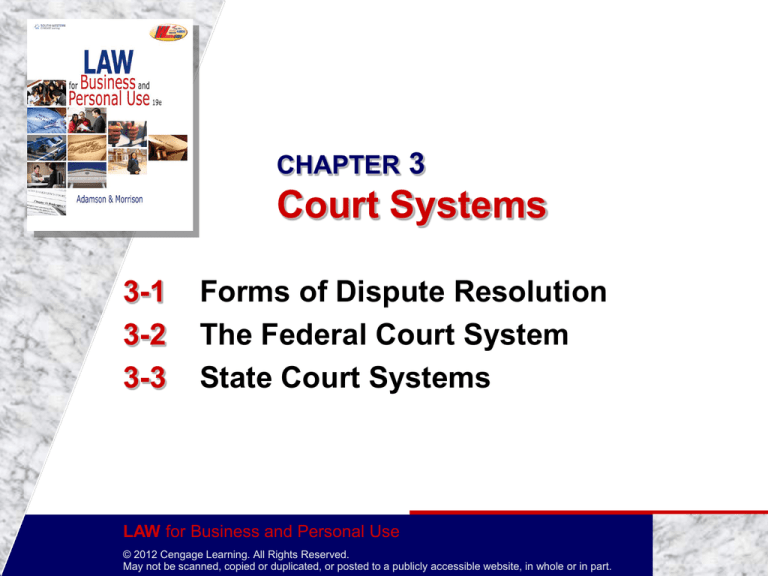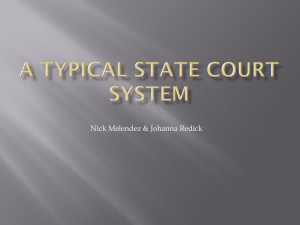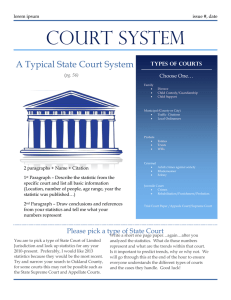
CHAPTER 3
Court Systems
3-1
3-2
3-3
Forms of Dispute Resolution
The Federal Court System
State Court Systems
LAW for Business and Personal Use
© 2012 Cengage Learning. All Rights Reserved.
May not be scanned, copied or duplicated, or posted to a publicly accessible website, in whole or in part.
3-1
Forms of Dispute Resolution
GOALS
Explain how disputes can be settled without going
to court
Name the different levels of courts and describe
their jurisdictions and powers
LAW for Business and Personal Use
Chapter 3
© 2012 Cengage Learning. All Rights Reserved.
May not be scanned, copied or duplicated, or posted to a publicly accessible website, in whole or in part.
SLIDE 2
DISPUTE RESOLUTION
Courts: Administers justice under the law
Awards damages, grants appropriate relief, and imposes
punishment
How can disputes be resolved without going to
court?
Litigate: allow a court to resolve their disputes
Negotiate Settlements: face to face negotiations without
going to court. Include:
Mediator: third party is invited into negotiations to help
settle the dispute. (not legally binding)
Arbitrator: similar to a mediator but ruling is legally
binding.
LAW for Business and Personal Use
Chapter 3
© 2012 Cengage Learning. All Rights Reserved.
May not be scanned, copied or duplicated, or posted to a publicly accessible website, in whole or in part.
SLIDE 3
DISPUTE RESOLUTION
How do courts settle disputes?
Courts: governmental forum that administers justice under
the law.
Trial courts: The court in which a dispute is first heard.
The trial court will apply what it selects as appropriate law to the
facts to reach a verdict, or decision, in the case.
Because it has the power to make these initials decisions of
fact and law, a trial court is said to have original jurisdiction
over the case. This is the power to hear the case in full for the
first time.
Bailiffs are responsible for summoning witnesses, keeping
order, and take steps to carry out judgments.
LAW for Business and Personal Use
Chapter 3
© 2012 Cengage Learning. All Rights Reserved.
May not be scanned, copied or duplicated, or posted to a publicly accessible website, in whole or in part.
SLIDE 4
DISPUTE RESOLUTION
How do courts settle disputes?
Appellate courts: reviews decisions of lower
courts when a party claims an error of law was
made during the lower court’s proceedings.
Appellate courts examine the transcript, which is
verbatim record of what went on at the trial.
The also read appellate briefs, or written
arguments on the issues of the law, submitted by
the opposing attorneys.
LAW for Business and Personal Use
Chapter 3
© 2012 Cengage Learning. All Rights Reserved.
May not be scanned, copied or duplicated, or posted to a publicly accessible website, in whole or in part.
SLIDE 5
CHECKPOINT
What are the two levels of courts, and what
is the function of each?
Trial courts are the forum in which legal disputes
are first heard.
Appellate courts review transcripts, evidence from
the lower courts, and legal briefs to ensure the
correct law was used and properly applied by a
particular trial court.
Only decide errors of law not errors of fact
LAW for Business and Personal Use
Chapter 3
© 2012 Cengage Learning. All Rights Reserved.
May not be scanned, copied or duplicated, or posted to a publicly accessible website, in whole or in part.
SLIDE 6
3-2
The Federal Court System
GOALS
Identify the source of power of the federal courts
Name the major federal courts and describe their
jurisdictions and powers
LAW for Business and Personal Use
Chapter 3
© 2012 Cengage Learning. All Rights Reserved.
May not be scanned, copied or duplicated, or posted to a publicly accessible website, in whole or in part.
SLIDE 7
ORIGIN OF THE FEDERAL COURT
SYSTEM
Congress established the Federal Judiciary
Acts:
U.S. Supreme Court
13 district courts
Federal Courts of Appeal (1891)
Specialized courts (1891)
LAW for Business and Personal Use
Chapter 3
© 2012 Cengage Learning. All Rights Reserved.
May not be scanned, copied or duplicated, or posted to a publicly accessible website, in whole or in part.
SLIDE 8
CHECKPOINT
Why do you think it was left to the discretion
of Congress to establish a Supreme Court
and other inferior courts?
The framers of the constitution thought they might
be able to do without these courts. They thought
the state courts could handle the case load.
LAW for Business and Personal Use
Chapter 3
© 2012 Cengage Learning. All Rights Reserved.
May not be scanned, copied or duplicated, or posted to a publicly accessible website, in whole or in part.
SLIDE 9
JURISDICTION OF THE FEDERAL
COURTS
General Jurisdiction: Can hear almost any
kind of case
3 levels of federal courts with general jurisdiction
Federal district courts, federal court of appeals, and US
Supreme Court
Specialized Jurisdiction: Hears only one
specific type of case.
Tax Court, Claims Court, Bankruptcy Court, etc.
LAW for Business and Personal Use
Chapter 3
© 2012 Cengage Learning. All Rights Reserved.
May not be scanned, copied or duplicated, or posted to a publicly accessible website, in whole or in part.
SLIDE 10
JURISDICTION OF THE FEDERAL
COURTS
Federal District Courts
Lowest federal court with general jurisdiction.
This is the trial court of the federal system
Will this case be heard in federal or state court?
Susan Bean, a citizen of Illinois, sued Wally Turk, a citizen
of the state of Colorado, for the breach of a construction
contract on Bean’s new Chicago residence. More than
$600,000 was at stake. Bean filed the suit in Illinois state
court. Turk filed a motion to remove the case to the federal
courts.
This case will be tried in federal courts. More than 75k in
question and between citizens of different states
LAW for Business and Personal Use
Chapter 3
© 2012 Cengage Learning. All Rights Reserved.
May not be scanned, copied or duplicated, or posted to a publicly accessible website, in whole or in part.
SLIDE 11
JURISDICTION OF THE FEDERAL
COURTS
Federal Courts of Appeals
Have appellate jurisdiction over district courts, certain
specialized federal courts, and many federal administrative
agencies.
There are 13 federal courts of appeals
United States Supreme Court
Has both original and appellate jurisdiction.
Has original jurisdiction according to the constitution, over
“cases affecting ambassadors, other public ministers and
consuls and those in which a state shall be party”.
LAW for Business and Personal Use
Chapter 3
© 2012 Cengage Learning. All Rights Reserved.
May not be scanned, copied or duplicated, or posted to a publicly accessible website, in whole or in part.
SLIDE 12
JURISDICTION OF THE FEDERAL
COURTS
United States Supreme Court (Cont.)
The most important function of the USSC is their
appellate jurisdiction.
If the Supreme Court believe that a case contains
a constitutional issue sufficiently important to be
decided by it, the Supreme Court will issue a writ
of certiorari to the last court that heard the case.
This “writ” or order compels the lower court to
turn over the record of the case to the USSC.
LAW for Business and Personal Use
Chapter 3
© 2012 Cengage Learning. All Rights Reserved.
May not be scanned, copied or duplicated, or posted to a publicly accessible website, in whole or in part.
SLIDE 13
FEDERAL COURT SYSTEM
LAW for Business and Personal Use
Chapter 3
© 2012 Cengage Learning. All Rights Reserved.
May not be scanned, copied or duplicated, or posted to a publicly accessible website, in whole or in part.
SLIDE 14
CHECKPOINT
Name the three levels of federal courts and
describe the jurisdiction of each.
LAW for Business and Personal Use
Chapter 3
© 2012 Cengage Learning. All Rights Reserved.
May not be scanned, copied or duplicated, or posted to a publicly accessible website, in whole or in part.
SLIDE 15
3-3
State Court Systems
GOALS
Compare the structure of a typical state court
system with the structure of the federal courts
Explain the jurisdictions of the specialized courts
in a typical state system
LAW for Business and Personal Use
Chapter 3
© 2012 Cengage Learning. All Rights Reserved.
May not be scanned, copied or duplicated, or posted to a publicly accessible website, in whole or in part.
SLIDE 16
A TYPICAL STATE COURT
SYSTEM
State Legal System
Mirrors federal in that it has 3 branches of government
State trial courts
In most states trial courts, those with general original
jurisdiction over both criminal and civil matters, are known
as circuit courts.
These courts are the court of record in the state system.
A court of record keeps an exact account of what goes on at
trial. The accuracy of this “record” is vital, as any appeal
filed depends on it.
These courts make decisions on facts often by using a jury.
LAW for Business and Personal Use
Chapter 3
© 2012 Cengage Learning. All Rights Reserved.
May not be scanned, copied or duplicated, or posted to a publicly accessible website, in whole or in part.
SLIDE 17
A TYPICAL STATE COURT
SYSTEM
State courts of appeals
The state panel (no more than 3 judges)
evaluates the record of the case and the
appellate briefs.
It hears oral arguments by those attorneys in the
case. No witnesses are called.
No new evidence can be introduced at this level.
The judges make sure the correct law was used
at the lower court and decide the case.
LAW for Business and Personal Use
Chapter 3
© 2012 Cengage Learning. All Rights Reserved.
May not be scanned, copied or duplicated, or posted to a publicly accessible website, in whole or in part.
SLIDE 18
A TYPICAL STATE COURT
SYSTEM
State supreme courts
Only case with the most vital and complex legal
issues are taken to the state supreme court.
Reviews a case in the same manner as the
appellate courts
They issue a final decision on the matters of law
appealed to them EXCEPT….
If the case involves a Constitutional or other federal
question, a further appeal can of the U.S. Supreme
Court.
LAW for Business and Personal Use
Chapter 3
© 2012 Cengage Learning. All Rights Reserved.
May not be scanned, copied or duplicated, or posted to a publicly accessible website, in whole or in part.
SLIDE 19
A TYPICAL STATE COURT SYSTEM
LAW for Business and Personal Use
Chapter 3
© 2012 Cengage Learning. All Rights Reserved.
May not be scanned, copied or duplicated, or posted to a publicly accessible website, in whole or in part.
SLIDE 20
CHECKPOINT
What does a typical state court system have
in common with the federal court system?
LAW for Business and Personal Use
Chapter 3
© 2012 Cengage Learning. All Rights Reserved.
May not be scanned, copied or duplicated, or posted to a publicly accessible website, in whole or in part.
SLIDE 21
STATE COURTS WITH
SPECIALIZED JURISDICTIONS
Associate circuit courts
The layer of courts below their main courts of general original
jurisdiction
City or municipal courts
Courts that administer city ordinances
Usually divided into traffic and non traffic division.
Can overlap with state laws and can be appealed to the state trial
court if necessary.
Small claims courts
Courts handle disputes in which small amounts, generally $2,500
or less, are involved.
Attorneys are typically not required
Can be appealed to state trial courts.
Minor suits would often not be heard if not for these courts.
LAW for Business and Personal Use
Chapter 3
© 2012 Cengage Learning. All Rights Reserved.
May not be scanned, copied or duplicated, or posted to a publicly accessible website, in whole or in part.
SLIDE 22
STATE COURTS WITH
SPECIALIZED JURISDICTIONS
Juvenile courts
Courts that handle cases for those over 13 and under the
age of 18.
Juveniles are entitled to full constitutional rights including
having an attorney
Ensure that most cases do not become public
Juvenile record cannot be used against you in another state
because these records are sealed.
Punishments are generally geared towards rehabilitation
and not punishment.
Probate courts
Courts that administer wills and estates
LAW for Business and Personal Use
Chapter 3
© 2012 Cengage Learning. All Rights Reserved.
May not be scanned, copied or duplicated, or posted to a publicly accessible website, in whole or in part.
SLIDE 23
CHECKPOINT
Name the typical state courts that have
specialized jurisdiction.
LAW for Business and Personal Use
Chapter 3
© 2012 Cengage Learning. All Rights Reserved.
May not be scanned, copied or duplicated, or posted to a publicly accessible website, in whole or in part.
SLIDE 24








